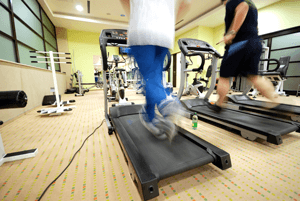Have you ever encountered a client you just can't read, not knowing when to push them or ease up? "Reading a client" is critical to a training session -- especially at that point when you don't know if they want to punch you or hug you!
Do you push on? You can't get this information from any pre-training questionnaire, you have to perceive it.
Reading a client's body language is an important skill that can determine the effectiveness of your training sessions and your trainer-client relationship. Not only can it be detrimental to your client (pushing them too hard possibly resulting in injury) but it can also be detrimental to you as a trainer (ineffective training sessions leading to less referrals). If you aren't a pro at it, don't worry -- you can develop these skills over time!
You're either born with this people skill or you need to develop it. Your training method may by the drill-sergeant type, the buddy-buddy type, or somewhere in-between, but reading your client allows you to know which trainer-hat to wear.
I'm going to show you how to understand the three main aspects of reading a client:
1) Map Out Expectations
2) Develop a Baseline Behavior Profile
3) Look for Baseline Delineations.
1. Map Out Expectations
First, you want to outline your expectations of a client and let them outline theirs before you even hit the gym floor. From your standpoint, tell a client what you expect of them, your training style, how aggressive you will be at pushing them, and your normal workout expectations. From their standpoint, they need to be up front and tell you how hard they want/need to be pushed and their workout expectations.
Mapping these out will make it a lot easier once you start the training session. You wouldn't go on a cross-country road trip without checking your oil, right? You don't want to go into a training session without going over expectations; it's the metaphorical oil to the workout!
Along with reading their body language (more of that in a minute), knowing a clients expectations will tell you how hard to train them. For example, your client expects you to push him to his limit. During the training session, you get to the end of the workout and he's close to being toast, without hesitation you know you need to push him through the final sets. While you're mapping out these expectations, start to develop a baseline profile of your client's normal behaviors to further get a read on them.

2. Develop a Baseline Behavior Profile
Immediately upon meeting your new client you need to develop a baseline profile of their behavior and body language (i.e., how they carry themselves, are they talkative, are audible, etc.) You also need to observe their confidence level and their fitness and equipment knowledge.
If they act timid, (won't make eye-contact, eyes always down, not sure of themselves around the equipment) you know you need to train with the softer buddy-buddy touch. You need to be constantly encouraging them, telling them they're doing great, when their form is perfect, using humor to break the ice, and just making the workout fun. That's what they're paying you for, to educate them, increase their fitness level, and make working out fun so they can eventually look forward to hitting up the gym without you.
On the other hand, if the client is of a greater fitness level and knows their way around a gym, the drill-sergeant approach may be needed. These clients have an air about them, know the equipment, the lingo, and carry themselves confidently. More than likely these clients are there for that drill-sergeant aspect you can offer. They're hiring you to basically push them to their limits, new personal records, and their peak.
Lastly, you have clients that are a mix of the first two, the intermediates. These clients are paying you to further educate them and take them to the next level. They have a reasonable exercise/equipment knowledge and are relatively confident but still have a way to go. This is where you wear both training hats -- buddy-buddy and drill-sergeant. Push them when they're dogging it but encourage when they're unsure of themselves. Get three more repetitions when they have some left in the tank, but be able to encourage them for just one more rep when the wheels are about to fall off.
This baseline behavior profile is of vital importance as it helps you make the sessions as effective as possible. When you combine the already known expectations with a baseline profile you start to get a read on your client and how to train them. Finally, it's time to test them and observe for delineations from their baseline behaviors.

3. Look for Baseline Delineations
When your clients are starting to hit that proverbial wall (usually last 15-10 minutes of the workout), we need to observe their body language for delineations from the baseline behavior profile. This is probably the most important time to read their body language. Look for key differences in their behavior from what you're used to observing. These differences can be small like a downcast facial expression or large like a completely different posture or attitude. Noticing these differences in their behavior and body language is what reading a person is all about.
Are they a very talkative person but suddenly won't respond during rest periods? They've likely hit the wall and you need to adjust accordingly. Are they still jittery with plenty of energy? You can finish the workout with a killer burnout set, HIIT session, or add another set. Keep an eye out for the key delineations from the baseline and adjust your workout plan accordingly.
It takes time and effort to naturally read people, but if you start to notice the little gestures and the body language of your clients you'll be able to read more into their current mental/physical shape. It's not easy, as psychology professor Dr. Ronald E. Riggio noted on the art of reading people,
"Well, sorry to inform you that body language -- nonverbal communication -- is fantastically complex, and there is no dictionary that you can use to translate...You can, however, get better at reading ("decoding") nonverbal cues, but it's not all that easy..."
The main point that Dr. Riggio makes is that you can learn this skill. Stick to the plan, map out expectations, develop a baseline reading of their behavior, and when the workout gets tough watch for delineations away from the baseline and react accordingly. Do this and overtime you'll become a better all-around trainer.
Learn to read -- it's worth it!










